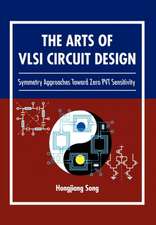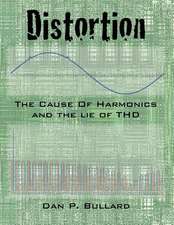E–CARGO and Role–Based Collaboration – Modeling and Solving Problems in the Complex World: IEEE Press Series on Systems Science and Engineering
Autor H Zhuen Limba Engleză Hardback – 9 dec 2021
E-CARGO and Role-Based Collaboration offers a unique guide that explains the nature of collaboration, explores an easy-to-follow process of collaboration, and defines a model to solve complex problems in collaboration and complex systems. Written by a noted expert on the topic, the book initiates the study of an effective collaborative system from a novel perspective. The role-based collaboration (RBC) methodology investigates the most important aspects of a variety of collaborative systems including societal-technical systems. The models and algorithms can also be applied across system engineering, production, and management.
The RBC methodology provides insights into complex systems through the use of its core model E-CARGO. The E-CARGO model provides the fundamental components, principles, relationships, and structures for specifying the state, process, and evolution of complex systems. This important book:
- Contains a set of concepts, models, and algorithms for the analysis, design, implementation, maintenance, and assessment of a complex system
- Presents computational methods that use roles as a primary underlying mechanism to facilitate collaborative activities including role assignment
- Explores the RBC methodology that concentrates on the aspects that can be handled by individuals to establish a well-formed team
- Offers an authoritative book written by a noted expert on the topic
Din seria IEEE Press Series on Systems Science and Engineering
- 9%
 Preț: 808.71 lei
Preț: 808.71 lei - 9%
 Preț: 956.89 lei
Preț: 956.89 lei - 8%
 Preț: 591.50 lei
Preț: 591.50 lei - 9%
 Preț: 989.96 lei
Preț: 989.96 lei - 8%
 Preț: 632.28 lei
Preț: 632.28 lei - 9%
 Preț: 693.50 lei
Preț: 693.50 lei - 9%
 Preț: 873.98 lei
Preț: 873.98 lei - 9%
 Preț: 795.46 lei
Preț: 795.46 lei - 8%
 Preț: 608.80 lei
Preț: 608.80 lei - 9%
 Preț: 749.87 lei
Preț: 749.87 lei - 9%
 Preț: 809.99 lei
Preț: 809.99 lei - 9%
 Preț: 812.41 lei
Preț: 812.41 lei - 9%
 Preț: 837.20 lei
Preț: 837.20 lei - 9%
 Preț: 754.29 lei
Preț: 754.29 lei - 9%
 Preț: 812.41 lei
Preț: 812.41 lei - 31%
 Preț: 553.55 lei
Preț: 553.55 lei - 32%
 Preț: 631.92 lei
Preț: 631.92 lei - 32%
 Preț: 498.09 lei
Preț: 498.09 lei - 32%
 Preț: 570.91 lei
Preț: 570.91 lei - 32%
 Preț: 671.97 lei
Preț: 671.97 lei - 30%
 Preț: 667.87 lei
Preț: 667.87 lei
Preț: 756.84 lei
Preț vechi: 831.69 lei
-9% Nou
Puncte Express: 1135
Preț estimativ în valută:
144.82€ • 151.61$ • 119.83£
144.82€ • 151.61$ • 119.83£
Carte tipărită la comandă
Livrare economică 05-19 aprilie
Preluare comenzi: 021 569.72.76
Specificații
ISBN-13: 9781119693062
ISBN-10: 1119693063
Pagini: 400
Dimensiuni: 152 x 229 x 25 mm
Greutate: 0.7 kg
Editura: Wiley
Seria IEEE Press Series on Systems Science and Engineering
Locul publicării:Hoboken, United States
ISBN-10: 1119693063
Pagini: 400
Dimensiuni: 152 x 229 x 25 mm
Greutate: 0.7 kg
Editura: Wiley
Seria IEEE Press Series on Systems Science and Engineering
Locul publicării:Hoboken, United States
Notă biografică
HAIBIN ZHU, PHD is a Full Professor and the Chair of Department of Computer Science and Mathematics, Founding Director of Collaborative Systems Laboratory, member of Arts and Science Executive Committee, Nipissing University.
Cuprins
Author Biography xi
Preface xiii
A Guide to Reading This Book xvii
Acknowledgments xix
Symbols and Notations (Nomenclature) xxi
Part I Backgrounds 1
1 Introduction 3
1.1 Collaboration and Collaboration Systems 3
1.1.1 Collaboration 4
1.1.2 Collaboration Systems 12
1.2 Collaboration as "Divide and Conquer" 13
1.3 Key Components of Collaboration 16
1.4 The Nature of Collaboration 18
1.5 The Complexity of Collaboration 20
1.6 Collectivism or Individualism 21
1.7 Collaboration and Complex Systems 24
1.7.1 What Are Complex Systems? 24
1.7.2 Examples of Complex Systems 26
1.8 Collaboration and Problem Solving 27
1.9 Summary 29
References 30
Exercises 34
2 Role Concepts 35
2.1 Terminology 35
2.2 Modeling-Roles 40
2.3 Roles in Agent Systems 42
2.4 Role-Based Access Control (RBAC) 45
2.5 Roles in CSCW Systems 48
2.6 Roles in Social Psychology and Management 51
2.7 Convergence of Role Concepts 53
2.8 Summary 58
References 60
Exercises 67
Part II Methodologies and Models 69
3 Role-Based Collaboration 71
3.1 Requirements for Role-Based Collaboration 71
3.2 Architecture of an RBC System 74
3.3 The Environment Established by Role-Based Collaboration 76
3.4 The Process of Role-Based Collaboration 79
3.5 Fundamental Principles of RBC 83
3.5.1 Object Principles 84
3.5.2 Agent Principles 85
3.5.3 Role Principles 85
3.5.4 Group Principles 86
3.6 Benefits of Role-Based Collaboration 87
3.6.1 Establish Trust in Collaboration 87
3.6.2 Establish Dynamics 88
3.6.3 Facilitate Interaction 90
3.6.4 Support Adaptation 91
3.6.5 Information Sharing 92
3.6.6 Other Benefits 93
3.7 Summary 93
References 94
Exercises 101
4 The E-CARGO Model 103
4.1 First Class Components 103
4.1.1 Objects and Classes 105
4.1.2 Roles and Environments 107
4.1.3 Agents and Groups 113
4.2 Second Class Components 118
4.2.1 Users or Human Users 118
4.2.2 Message 118
4.2.3 System 120
4.3 Fundamental Relationships in E-CARGO 121
4.3.1 The Relations Among Roles 122
4.3.2 The Relations Between Roles and Agents 129
4.3.3 The Relations Between Agents 130
4.3.4 Properties of an RBC System 132
4.4 Related Work 133
4.5 Summary 135
References 136
Exercises 140
5 Group Role Assignment (GRA) 141
5.1 Role Assignment 141
5.2 A Real-World Problem 142
5.3 Extended Expression of the E-CARGO Model 145
5.4 Group Role Assignment Problems 146
5.4.1 Simple Role Assignment 146
5.4.2 Rated Group Role Assignment 147
5.4.3 Weighted Role Assignment 148
5.5 General Assignment Problem and the K-M Algorithm 148
5.6 Solutions to GRA Problems 152
5.7 Implementation and Performance Analysis 159
5.8 Case Study by Simulation 161
5.9 Related Work 165
5.10 Summary 166
References 168
Exercises 170
6 Group Role Assignment with Constraints (GRA+) 173
6.1 Group Multi-Role Assignment (GMRA) 173
6.1.1 A Real-World Scenario 173
6.1.2 Problem Formalization 175
6.1.3 The CPLEX Solution and Its Performance Experiments 176
6.1.4 Improvement of the CPLEX Solution 177
6.1.5 Comparisons 180
6.2 Group Role Assignment with Conflicting Agents (GRACA) 181
6.2.1 A Real-World Scenario 181
6.2.2 Problem Formalization 183
6.2.3 The Benefits of Avoiding Conflicts 186
6.2.4 GRACAR/G Problems Are Subproblems of an NP-Complete Problem 188
6.2.5 Solutions with CPLEX 194
6.3 Group Role Assignment with Cooperation and Conflict Factors 195
6.3.1 A Real-World Scenario 195
6.3.2 Problem Formalization 196
6.3.3 A Practical Solution 200
6.3.4 Performance Experiments 202
6.3.5 The Benefits 203
6.3.6 Cooperation and Conflict Factor Collection 204
6.4 Related Work 206
6.5 Summary 207
References 208
Exercises 212
7 Group Role Assignment with Multiple Objectives (GRA++) 213
7.1 Group Role Assignment with Budget Constraints (GRABC) 213
7.1.1 A Real-World Scenario 213
7.1.2 Problem Formalization 215
7.1.3 Solutions with an ILP Solver 224
7.1.4 Simulations of GRABC-WS and GRABC-Syn 226
7.1.5 Performance Experiments and Improvements 227
7.1.6 Synthesis 229
7.2 Good at Many Things and Expert in One (GMEO) 229
7.2.1 A Real-World Scenario 231
7.2.2 Problem Formalizations 232
7.2.3 A Solution with CPLEX 235
7.2.4 Performance Experiments and Improvements 237
7.2.5 A Simple Formalization of GMEO with an Efficient Solution 240
7.2.6 A More Efficient Solution for GMEO-1 243
7.3 Related Work 246
7.4 Summary 248
References 249
Exercises 251
Part III Applications 253
8 Solving Engineering Problems with GRA 255
8.1 Group Role Assignment with Agents' Busyness Degrees 255
8.1.1 A Real-World Scenario 256
8.1.2 Problem Formalization 257
8.1.3 Solutions 259
8.1.4 Simulations and Benefits 261
8.2 Group Multi-Role Assignment with Coupled Roles 264
8.2.1 A Real-World Scenario 265
8.2.2 The Problem Specification 267
8.2.3 The Solutions with CPLEX and Initial Results 269
8.2.4 Verification Experiments 270
8.3 Most Economical Redundant Assignment 271
8.3.1 A Real-World Scenario 272
8.3.2 Problem Formalizations 273
8.3.3 A Solution with CPLEX 274
8.3.4 A New Form of the MERA Problem and a More Efficient Solution 277
8.4 Related Work 281
8.5 Summary 283
References 284
Exercises 287
9 Role Transfer 289
9.1 Role Transfer Problems 289
9.2 The M-M Role Transfer Problems 292
9.2.1 M-1 Problem 294
9.2.2 1-M Problem 294
9.2.3 M-M Problem 294
9.3 From M-M RTPs to Role Assignment Problems 297
9.4 Temporal M-M Role Transfer Problems 300
9.4.1 Temporal Transfer with Weak Restriction 300
9.4.2 Temporal Transfer with Strong Restriction 304
9.4.3 A Near-Optimal Solution to SRTP with the Kuhn-Munkres Algorithm 309
9.4.4 Performance Experiments 314
9.5 Role Transfer Tool 315
9.6 Related Work 317
9.7 Summary 318
References 319
Exercises 322
10 More to Investigate 323
10.1 Role Negotiation 323
10.2 Role Specification 324
10.3 Agent Evaluation 324
10.4 Collective Group Role Assignment 327
10.4.1 One-Way Collective Role Assignment 328
10.4.2 Two-Way Collective Role Assignment 329
10.5 Role Engine 330
10.5.1 Role Dynamics 331
10.5.2 Role Interaction 332
10.5.3 Role Presentation 332
10.6 Social Simulation 333
10.7 Adaptive Collaboration 335
10.8 Other Challenges in RBC and E-CARGO 336
10.8.1 Optimizations 338
10.8.2 Agent-Oriented Software Engineering (AOSE) 338
10.8.3 Multi-Agent Systems 339
10.9 Not the End 339
References 341
Index 349
















